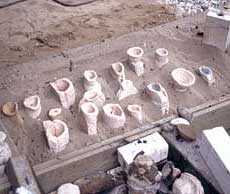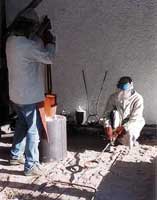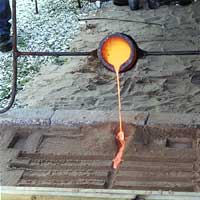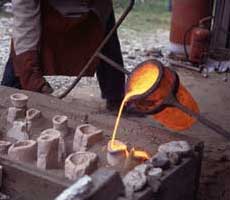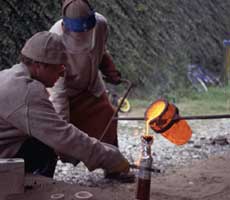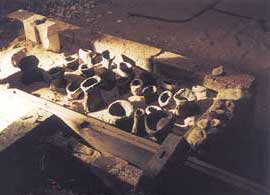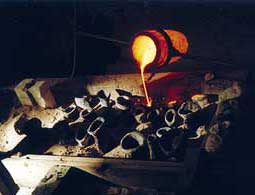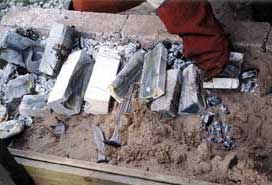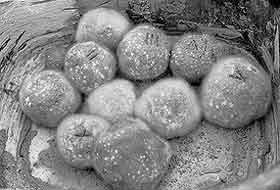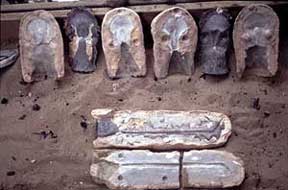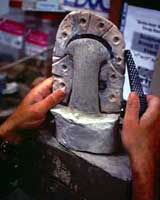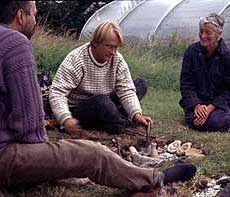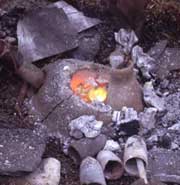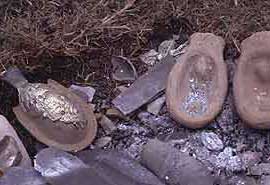
|
Made in a steel drum, lined with ceramic fibres held on by wires and clay
buttons. Lid has a vent and arms for lifting. Gas fired using a Propane
tank. Pouring area has sand floor.
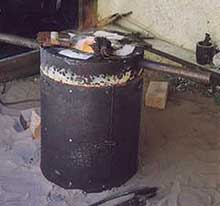
Gas Furnace |

Lifting shank |
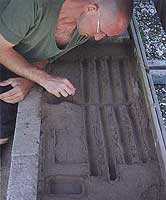
Holger preparing ingot moulds in sand. |
Copper pipes are beaten flat, cut or concertinaed handspan size. They
are weighed in to bundles of 1kg made up with 75g of tin solder and tied
together with copper wire than placed in piles with an addition of a 50g
piece of leaded-tin solder. The crucible will normally take six of these
bundles (and sometimes up to eight) The sound of hammering ringing in
the ears predicating the expectant roar of the furnace
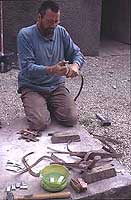
Bernd preparing scrap copper,
tin & leaded-tin quantities |
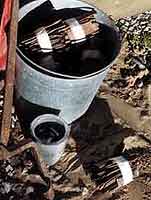
Measured bundles ready for the melt. |
When the noise from furnace has become a steady foreground roar two or
three women squat in position around pits, they are moving sand and moulds.
There is one glowing charcoal pit laden with clay moulds and one smooth
sand bed raked and ready. One Squatter is in charge of removing hot moulds
from the hot pit with tongs, another prepares the sand and, hand in glove,
accepts and positions the moulds. Meanwhile the third Squatter builds
up sand around their bases.Hot charcoals are removed with tongs from the
charcoal pit and placed around the upright moulds like smouldering embers
of a post apocalyptic city.
Pourers survey the pits and design choreography for The Pour by establishing
the order of the moulds. Hottest matter must go into the most complex
mould. Pourers spend moments perched by the roaring metal drum, angling
body and craning neck to peer, bird-eyed into the blinding vent of the
furnace. When the metal is moulten and has a mirror surface, the hiss
of gas is shut off to silence. The furnace lid is lifted by the Pourers
and placed to the ground. The 'Steady Pourer' takes up position at the
single tine of the pouring fork and raises this end slighty from the ground
to form an angled "O" to safely hold the crucible.
Red and glowing the crucible is removed from the silent interior of the
hot furnace. Using large vertical tongs, the Lead Pourer places the radiant
crucible into the angled pouring fork. The two Pourers lift the fork horizontal
together, the hot crucible glows between them. Lead Pourer controls movement,
Steady Pourer follows, making no independant moves. A Scraper is in place
to remove slack from surface of the moulten bronze.
The metal flows liquid light, from crucible to mould, mirror flashes glancing
the surface. Moulds drink metal, some surrender as liquid runs out through
seams, others spit and gag, most accept, like greedy cuckoos, metal turning
solid in their bellies. The Scraper minds the crucible lip, keeping it
clean for even pours and, when metal runs solid will remove 'marmalade'
of congealing matter from the cooling surface of the empty vessel. The
moulds digest, liquid becomes solid.
After The Pour, tied stone moulds' wires are snipped immediately and casts
are released. Clay moulds are placed sizzling into a bucket of cold water
which is quickly brought to boil and an offer of tea is casually made.
Warm clay flasks are lifted out and prised apart, more or less gently
tapped with a hammer, metal is eased out as spectators move closer to
survey the booty.
Dymphna, who loves her flashing and who rarely 'finishes' her pieces,
made a mysterious figure, carved from a small branch with one arm and
flying head gear, this was placed in a clay mould made like a book with
two flat pages and tied together with wire. On the last day she emmerged
from The Pour like an Egyptian divinity held within the lacy filigree
of elaborate flashing as if she was walking out of the pages of an ancient
manuscript.
James, who had been experimenting with lost wax and core making techniques,
made some exquisite spheres, tiny with blackened cores, one had spaces
carved into it like lost continents, they looked like planets from St
Exuprey's "Little Prince". Holger, had concocted various recipes using
organic matter resembling oatcakes or muesli which seemed more at home
on the breakfast table than the foundry, (that is until they grew hairs
and turned into gremlins!) This collection of muesli balls were carefully
numbered and tested for success as cores for some excquisite lost wax
busts, the size of a fist. Even the moulds for these pieces were beautifully
formed organic flask shapes, genies' bottles, holding a form which was
struggling to be released.
Fiona, ceramicist and experimentor with clay and dung made some fine 'cows
heads' (non weaponry axes) and shared her knowledge of clay moulds in
flask forms, building fine walls of pinched clay/donkey dung around a
stoneware lining: these moulds en masse looked like a highway man's booty
of drawstring leather purses. Cordula became the Umha Aois Minter, she
designed a commemorative medallion in wax and made a plaster mould in
which she cast further wax replicas and made small clay purses around
them, the wax was drawn gently from them over warm charcoals and opened
from the Pour like a meadow of flowers at first light of day. There was
more, Bernt's expertly crafted soap stone mould with joining pins produced
a finely detailed domed and bossed brooch, Irene who rarely makes complete
circles, carved a 'donut' from local stone which was reproduced as a beautiful
soft bronze form, heavy in the hand and somehow capturing the sense of
many cycles present, past and future in its weighty stillness. Parra made
a collection of chisels, and, remaining perfectly in the memory, a beautiful
beeswax donkey comb in recognition of The Great Provider of Dung, it sadly
became overheated and melted too soon and formed a bond with the organic
compounds in the clay mould, ashes to ashes...
Niall, apart from being the Bronze Consultant made a clay mould for an
axe head, using Fiona's technique which he said was 'like modelling in
air', the core for his axe was an amazing object hairy, organic and perfectly
formed. The resulting bronze appealled to me in its incompleteness of
form but not I think to his perfectionist self. Padhraic made a perfect
spearhead, dynamic as he, Maire the master mould maker had a great success
rate in brooches from bronze age design and a mysterious obect (...) that
is believed to have been for ceremonial use, a (heavy) bauble which may
have been attatched in number to clothing to transform the wearer to appear
as a many breasted figure (Ephesus) Cliona made a magical mirror, the
mould carved from stone that she brought, Anders had no great success
with the moulds he brought but his attention was focussed on the building
of a Neolithic Furnace, which uses updraught and was magnificent, reaching
temperature and forming liquid bronze even in the low atmospheric pressure
conditions of the final day, he also made successful experiments in glass
in his pit furnace.
There were other successes from the islanders; John Mc Curdy's little
bronze boat, Jennifer's axehead, Brian's ornately carved objects, one
mould made in sandwiched sections to produce multiple pieces, Jonathan's
axe head made with a spectacular "nose" mould where the liquid bronze
helter skeltered the pouring hole and slid into place and bulged out the
"eye" holes, amazingly cooling to form a plug before seepage could occur.
Paddy's spear head, Penny's bronze bowl, (another breast form), Eilis's
little boat from a 2 piece stone carved mould, visitor's made a little
lizard in the most amazing donkey dung mould with wax twigs for spru holes
bristling out of the top and a perfectly fleshy tiny frog from wax. Resident
silversmith Johnny Fyffe made a spear head modelled on three that he found
during an architectural salvage (and which is the basis for a contoversial
thesis he has written about bronze age lost wax technique) and presented
it to Niall complete with haft and feathers! My own favourite piece was
from a small thread of seaweed I found, already twisted to torc shape
which I pressmoulded in clay. The mould produced flashing and the fired
stoneware became integrated with the object, a curious piece (that didn't
want to become worn), to remind me of the strand where the islanders used
to collect kelp for iodine in exchange for rent.
The Umha Aois Organizing Committee would like to acknowledge (and thank!)
all the participants, technicians and facilitators:
Julie Forrester, Cordula Hansen, Irene Benner, Bernd Hansen, Parra Ó Síocháin, Marie Ní Gabhann, Eilis O'Baoill, Anders Söderberg,
Fiona Coffey, Pádraig McGoran, Holger Lönze, Cliodna Cussen,
Dympna Molloy, Niall O'Neill, and James Hayes.
We would also like to thank our sponsors:
The Rathlin Island Co-operative Society Ltd., The Arts Council of Northern
Ireland, Foras na Gaeilge, BOC Gases, Bronze Art Ltd., Cast Ltd., Coldec,
P.J. Dix, Isaac Mullen Ltd., Fordham Thermal Systems, James Murphy & Son, RPM, Scarva Pottery Supplies Ltd., Silica Sand Co., and Weldtech.
|







